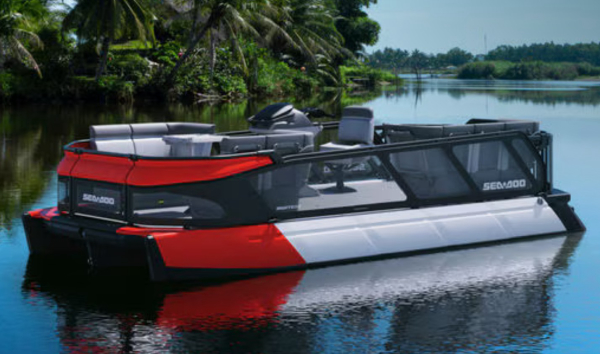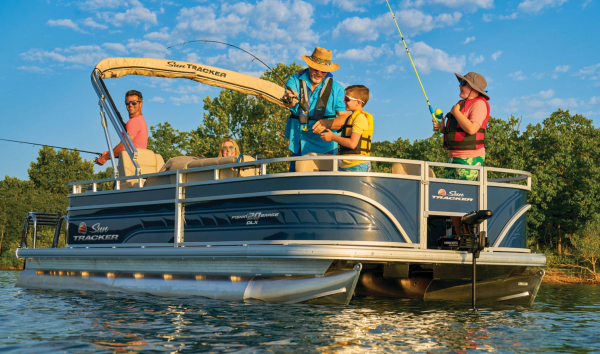
Bombardier Recreational Products (BRP), the manufacturer of the Sea-Doo Switch, has issued a safety recall for these affordable waterjet-powered pontoon boats.
The Switch pontoon boat looked like a great idea when it was introduced three years ago, a truly economical composite pontoon boat that steered with handle bars like a jet ski and relied on SeaDoo’s proven waterjet propulsion system, eliminating the dangers of open propellers for swimmers and board sports.
However, following several accidents, the company has issued a bulletin advising all buyers to make several alterations to the hulls to make the boats safer. The accidents involve “nose-diving”, or rapid submerging at the bow. You can see the advisory here: https://sea-doo.brp.com/us/en/owner-zone/safety/safety-recalls/front-overload-risk-of-capsizing.html
“Sea-Doo Switch watercrafts complied with all ABYC and US Coast Guard regulations regarding flotation testing and weight capacity,” per the company “This product has been rigorously tested throughout its development phase and still is today. As such, BRP strongly believes that the Sea-Doo Switch watercraft is a well designed and safe product.”
The company says it will, at no cost to owners, make necessary changes to the pontoon system to help keep the bow elevated and reduce the chances of accidents.
While it remains to be seen/legally determined if there are design flaws in the Sea-Doo Switch, it behooves all pontoon boat owners to take some lessons from the difficulties these boats ran into.
The potential problem with the Switch design apparently is that the triple-pontoon or tritoon system used to float the boats allows water to flow into the pontoons to act as ballast on the relatively light boats, making them more stable.
But it appears that in some cases—as in rapidly dropping off plane or hitting a large wave—the ballast water can flow forward, weighting down the bow. If the bow is already low due to too many passengers forward, this can cause the front of the boat to submerge, and in a set of unfortunate circumstances to flip or capsize.
BRP’s recall alert advises owners to have the ballast system partially sealed off to prevent too much water from rolling forward and creating an issue, which hopefully reduces the risk considerably.
But the possible risk of pontoons taking a nose dive is not limited to this particular design, by any means

Pontoons Are Not Rough Water Boats
While conventional pontoon boats have sealed pontoons, nearly always aluminum, they too can allow the bow of the boat to “stuff” into large seas—or even small waves if too many people get up on the bow.
Pontoons don’t have the usual freeboard and flared bow seen in monohull boats, so they are not good boats for open water or steep seas. (They’re exceptionally stable in beam seas so long as the waves are not excessive, however—the broad stance of the pontoons offers a lot of resistance to rocking, which is one of the reasons pontoons are so popular with beginning boaters.)
Pontoon safety is becoming more of a potential problem as larger, faster pontoons are being sold—some with 300-hp outboards or even twin 300’s that produce mile a minute speeds in specialized tritoon designs. While the larger boats ride on larger pontoons, they’re still subject to the same issues of overloading at the bow in rough water.

A pontoon that’s rated to carry 12 people can safely do so if only one or two are forward and the rest are amidships or aft. But put 10 of them up front and even an XL pontoon might stuff the snoot into the first steep wave or even a large wake from another boat.
For that matter, if you put 10 people on the bow of a 30’ offshore v-hull boat and try to go through Haulover Inlet when big waves are rolling in at the same time a strong tide is flowing out, you’ll probably stuff the bow and at the very best soak everybody aboard.
As in all boating, safety in pontoons comes down to common sense and always being aware that water is literally a fluid medium that is capable of “going vertical” under some conditions, making it dangerous for those not aware of the possibilities for trouble.
— Frank Sargeant
Frankmako1@gmail.com
(Frank Sargeant is the author of “The Complete Idiot’s Guide to Boating & Sailing”, a former charterboat captain and contributor to numerous national boating publications.)